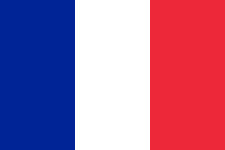
Dans son projet de rénovation du centre historique de Rouen « Coeur de Métropole », la Métropole de Rouen Normandie a largement utilisée une pierre mythique pour ses nouveaux aménagements urbains de la place du Vieux Marché : le Porphyre.

Le terme porphyre tire son nom du grec ancien πορφύρα, porphýra qui signifie pourpre, la variété la plus connue de ce temps.
En pétrographie, il désigne toute roche magmatique caractérisée par de grands cristaux de feldspath noyés dans une pâte aphanitique, ce qui le fait appartenir au groupe des andésites. Une texture dite « porphyrique » indique des phénocristaux de feldspath plus grands que les cristaux qui l’encerclent. Le rouge ou lapis porphyrites est une andésite à faciès paléovolcanique colorée par de l’épidote rose dit piémontite, espèce minérale faisant partie du groupe des silicates.
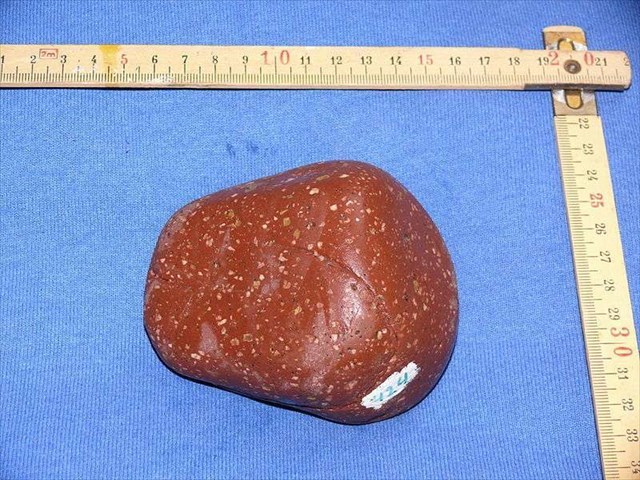
L’Égypte possède l’unique gisement connu de l’Antiquité, situé près du Djebel Dokhan en plein milieu du désert et c'est la dynastie des Ptolémées qui commence à l'utiliser alors que les précédents pharaons lui préféraient d'autres types de pierre. Cette variété a été essentiellement exploitée pendant l’ère romaine qui en fit un matériau noble et impérial, principalement utilisé pour la construction de bâtisses imposantes, des sarcophages majestueux et autres décors monumentaux.
Il est connu pour sa dureté extrême qui détrônait même celle du marbre calcaire, et nécessitait donc des années entières de travail et de sculpture étant donné les outils de l'époque. Il était de ce fait considéré comme la pierre la plus prestigieuse de l’ère antique romaine, symbole incontestable de la force impériale, strictement réservé à l’ornementation des monuments.
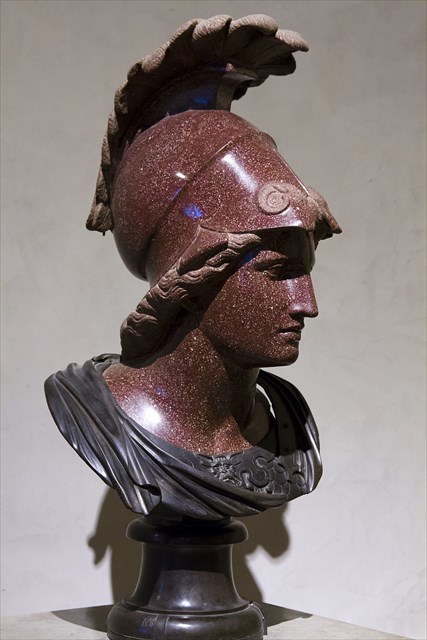
À partir du Moyen-âge, son exploitation fut interrompue et tout le savoir-faire qui l’entourait perdu. Au XVIIIe siècle on commence à réutiliser le Porphyre issu des anciens monuments romains pour l'architecture. Peu de temps après apparaissent de nouveaux sites d'extraction en Russie et en Suède.
Aujourd'hui, les principales carrières se situent dans le Trentin en Italie — 1,5 million de tonnes par an —, Australie, Mexique et Argentine, mais également en Belgique avec une production de 1,8 million de tonnes par an dans la carrière de Ouenast. Par ailleurs, celui de couleur rose de Corse — d’Algajola — est très réputé.
Le Porphyre a aujourd'hui perdu la noblesse qui faisait de lui un matériau précieux. Actuellement, on l’utilise essentiellement pour faire des pavés, car très solide, ou pour la décoration, si toutefois il est adroitement polie. Ce matériau hautement résistant a participé à la construction de plusieurs ouvrages très célèbres comme celui du plan Delta aux Pays-Bas ou du tunnel qui passe sous la Manche. Il est aussi utilisé pour les chemins de fer des lignes TGV et pour les routes asphaltées.
(source : Wikipedia)
Les questions:
La lecture attentive du descriptif de la cache, ainsi qu'une observation des éléments de terrain sont normalement suffisants pour répondre aux questions de cette EarthCache.
Q1 : Décrire la structure cristalline de la roche utilisée pour le mobilier urbain (bancs) de la place du Vieux Marché (couleur, dureté). Voyez-vous une différence de taille entre les cristaux, que pouvez-vous en déduire sur le type de texture de la roche ?
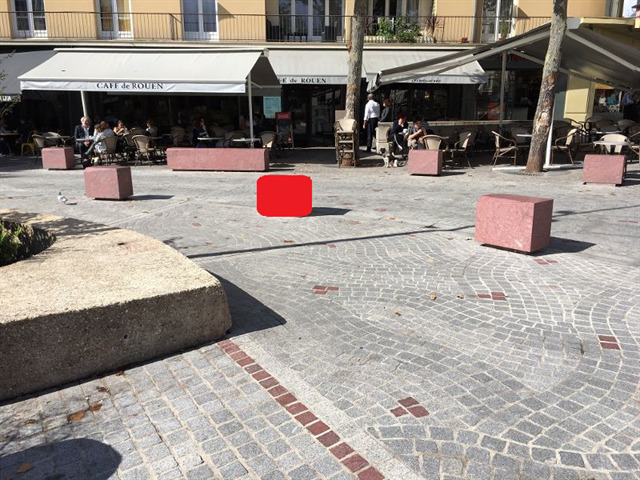
Q2 : Quelles sont la taille et la couleur des cristaux de feldspath présents sous le cache rouge de la photo ?
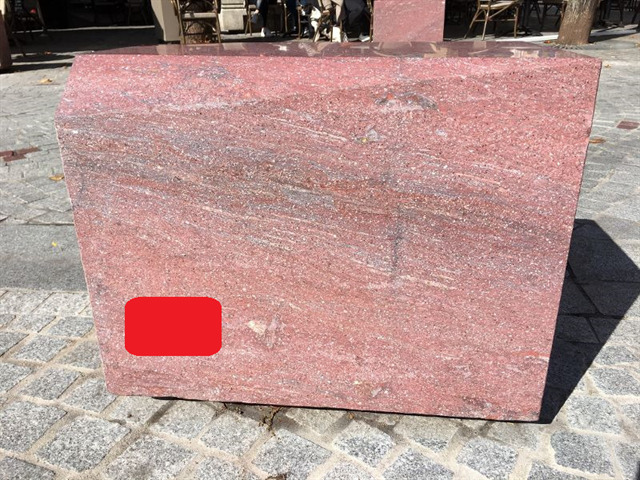
Q3 : Quelle différence voyez-vous entre la roche des contremarches de l'escalier et celle utilisée pour les bancs précédemment étudiés ?
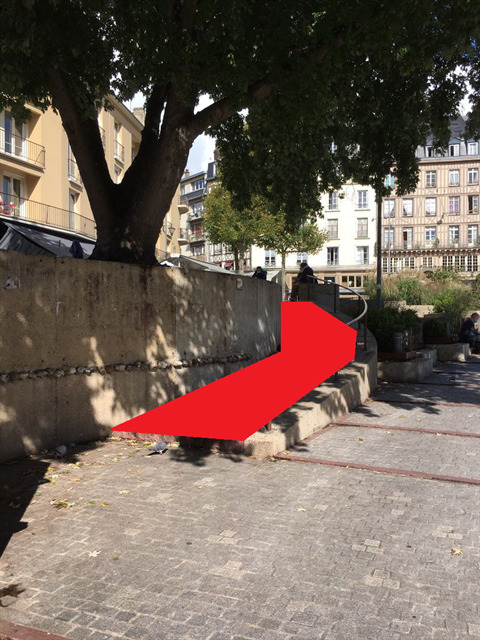
Vous pouvez loguer cette cache sans attendre de confirmation, mais vous devez envoyer les réponses en même temps soit par mail via mon profil, soit via la messagerie geocaching.com (Message Center).
S'il y a des problèmes avec vos réponses je vous en ferai part. Les logs enregistrés sans réponses seront supprimés.
Une photo de vous ou de votre GPS sur la place du Vieux Marché est la bienvenue, mais n'est pas obligatoire.

In its project to renovate the historic center of Rouen “Coeur de Métropole”, the Métropole de Rouen Normandie has widely used a mythical stone for its new urban developments in the Place du Vieux Marché: the Porphyry.

The term porphyry takes its name from the ancient Greek πορφύρα, porphýra which means purple, the most famous variety of this time.
In petrography, it designates any magmatic rock characterized by large feldspar crystals embedded in an aphanitic paste, which makes it belong to the andesite group. A so-called "porphyritic" texture indicates feldspar phenocrysts that are larger than the surrounding crystals. Red or lapis porphyrites is an andesite with a paleovolcanic facies colored by pink epidote known as piemontite, a mineral species belonging to the silicate group.

Egypt has the only known deposit of Antiquity, located near Jebel Dokhan in the middle of the desert and it is the dynasty of the Ptolemies that begins to use it while the previous pharaohs preferred other types of Pierre. This variety was mainly exploited during the Roman era which made it a noble and imperial material, mainly used for the construction of imposing buildings, majestic sarcophagi and other monumental decorations.
It is known for its extreme hardness which dethroned even that of limestone marble, and therefore required entire years of work and sculpture given the tools of the time. It was therefore considered the most prestigious stone of the ancient Roman era, an indisputable symbol of imperial strength, strictly reserved for the ornamentation of monuments.

From the Middle Ages, its exploitation was interrupted and all the know-how that surrounded it was lost. In the 18th century, we began to reuse Porphyry from ancient Roman monuments for architecture. Shortly after, new extraction sites appeared in Russia and Sweden.
Today, the main quarries are located in Trentino in Italy - 1.5 million tons per year - Australia, Mexico and Argentina, but also in Belgium with a production of 1.8 million tons per year in the quarry. from Ouenast. Moreover, the pink one from Corsica - from Algajola - is very famous.
Porphyry has today lost the nobility which made it a precious material. Currently, it is mainly used for making pavers, because it is very solid, or for decoration, if however it is skillfully polished. This highly resistant material has taken part in the construction of several very famous structures such as the Delta Plan in the Netherlands or the tunnel which passes under the Channel. It is also used for the railways of TGV lines and for asphalt roads.
(source : Wikipedia)
The questions:
Careful reading of the cache description, as well as observation of terrain elements are normally sufficient to answer the questions of this EarthCache.
Q1: Describe the crystalline structure of the rock used for the street furniture (benches) of the Place du Vieux Marché (color, hardness). Do you see a difference in size between the crystals, what can you deduce from the type of texture of the rock?

Q2: What is the size and color of the feldspar crystals present under the red cover in the photo?

Q3: What difference do you see between the rock of the stair risers and that used for the benches previously studied?

You can log this cache without waiting for confirmation, but you must send the answers at the same time either by mail via my profile, or via geocaching.com (Message Center).
If there are any problems with your answers, I will let you know. Saved logs without answers will be deleted.
A photo of you or your GPS in front of the cathedral is welcome, but is not mandatory.